#32: Snake Women by Boris Vallejo
Snake Women by Boris Vallejo, copyright 1980. From his book Mirage.
This analysis copyright 2010 by Scott M. McDaniel.
The Image
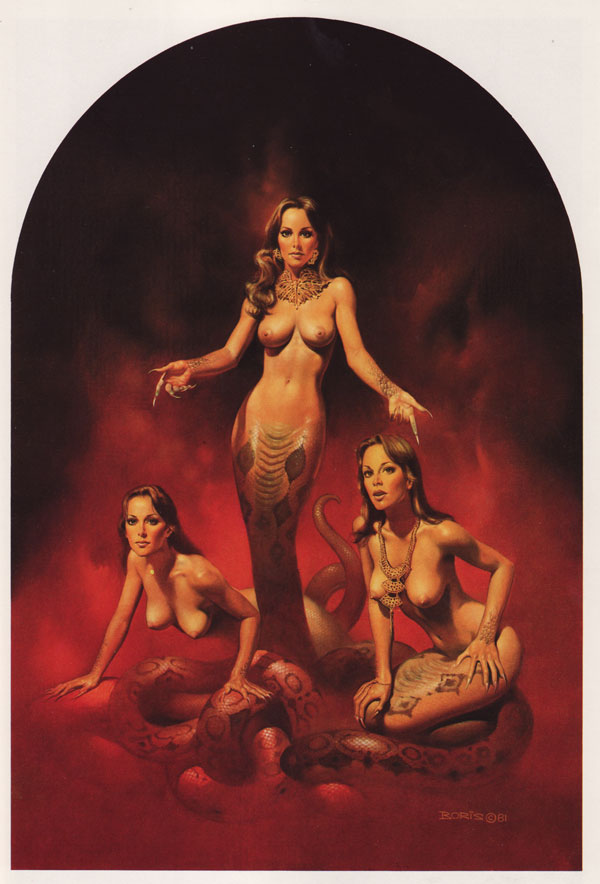
When I decided to do a Vallejo picture here I asked my Facebook friends list what kind of cheese they thought best represented his art. Answers were generally high-end or gourmet: Raclette, Manchego, Pont-l’Évêque, Gouda. Someone threw out “processed cheese food,” but I think I’d have to go with Havarti. I like Havarti. And the cheese enthusiast in me likes Vallejo. He’s the first artist I learned to identify based on style alone.
Unfortunately I can’t find a link, but I once saw a cartoon with a woman in a +5 chain mail bikini. She had half a dozen arrows stuck in the chinks on her bosom, and she was saying how glad she was she wore her armor. (I think it was in a Dragon magazine.) Anyway, Vallejo epitomizes that barely-there style of fantasy clothing. It fails in providing warmth or protection, but it allows publishers to put naked babes and guys on book covers without being sued. I also think it dovetailed with Vallejo’s love of painting the ideal human form. This painting, Snake Women, is from his book Mirage. Here he dispenses with the chain mail bikini level entirely to create fantasy erotica.
The Composition
I’m going to get into more specifics of style shortly, but first lets start with the basics of the composition. The image is a vignette that shows three snake women, apparently identical. The basic shape is a triangle with the middle woman’s head at the top and the mass of snakes at the bottom as the base.
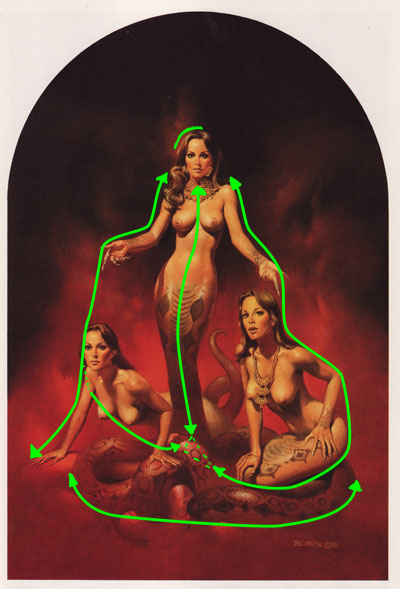
As a vignette there is a hint of background, but this picture isn’t part of a larger scene or narrative. It’s a character study. As such, Vallejo sets up several pathways to guide our eyes from snake-person to snake-person. The tallest woman’s hands take us directly to the women on either side, and their poses generally guide us across the picture to each other. The one exception is the arm of the woman on the left. It points down and left, out of the painting. It’s certainly necessary for balance in the pose, though, and it’s not that hard to get back into the main painting.
The Values and Color
This is a very dark painting. Take a look at the greyscale version:
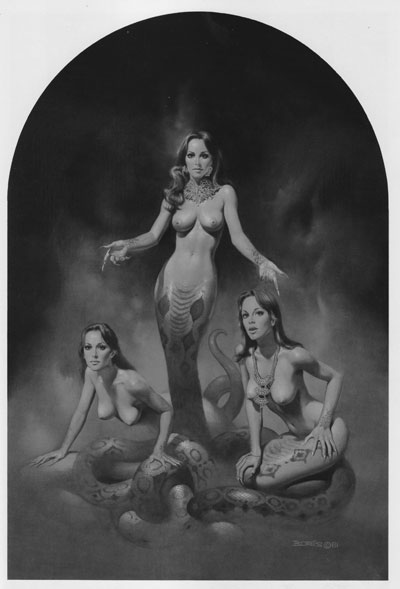
Vallejo also goes with a narrow color palette:
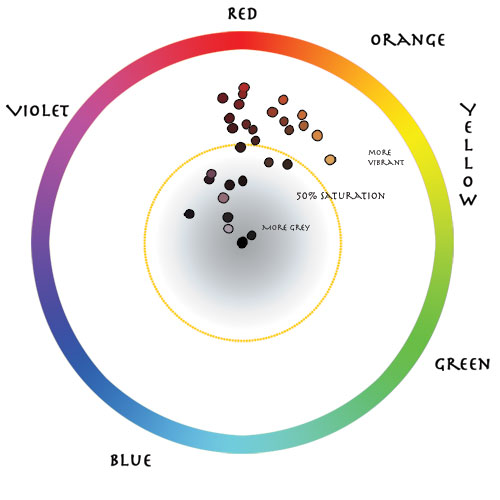
He ranges from yellow to reds, with just a couple of purples. What is remarkable, though, is how much saturation he uses. This is the most saturated image I’ve analyzed up to this point. The dark, intense reds create a mood of danger and give us an other-worldly, hellish setting.
The subject matter reinforces the hellish mood – snakes symbolize danger and cunning. Not only is there the serpent in the garden of Eden, but snakes can also be physically dangerous. The combination of color and snakes puts us on our guard, and I’d say even the posture of the snake women provide warning. It’s a little too inviting. The open arms and gorgeous women are an invitation, of course, and that conflict is what Vallejo is playing with here. It’s the central concept of the painting. Not all erotica is safe and romantic – the danger can be a turn on.
The Style
Wikipedia refers to Vallejo’s “hyper-representational paintings.” The style appeals to me in part because I like the contrast between fantastical creatures and realistic painting. A heavily stylized picture of these same snake women wouldn’t carry the same impact. Imagine a Picasso version of them. We’d be so focused on the style and shapes that we’d only get to the snake women later, once we parsed the picture. So much for the sense of danger and wonder.
So what is it that makes this painting classically “Vallejo”? Here are some elements that I see repeated over and over again in his work:
- Realistic modeling of form and volume
- Smooth painting – that is, no visible brush strokes or lines
- High color saturation
- Minimal or absent clothing
- Fantasy anatomy – whether muscles or curves the bodies are his idea of perfect
- Spot-on anatomy – he loves to paint the human form and he is good at it
- Contemporary hair and make-up styles
- Neutral or de-emphasized facial expressions
- Pin-up postures, often dramatic
- Combination of human and animal forms, drawing heavily on mythology and fantasy
When I say pin-up postures, what I mean is that often it seems as if the figures are carefully posed and often aware of being watched. In this case, the snake women are aware of the viewer and want us to look at them. (I keep hearing Madonna’s “Vogue” in my head.) Vallejo does action illustrations too, of course, but even those have a quality of the posture being arranged more to show off the body than to convey the action. While I don’t know him, my guess is that this part of his style reflects what he enjoys painting.
It’s interesting to look through the pictures on his site and watch how he handles facial expressions. The expressions in this painting are typical of his late ’70’s and early ’80’s work. You either see neutral, slightly come-hither looks or expressions that are inward-focused: closed-eyes and blissing out on sensation.
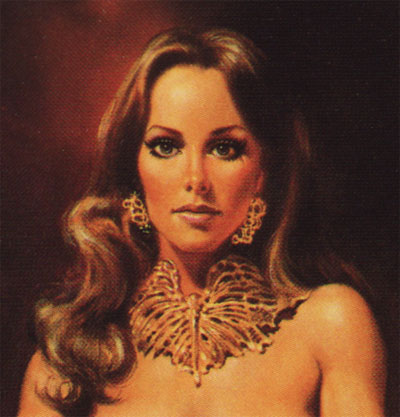
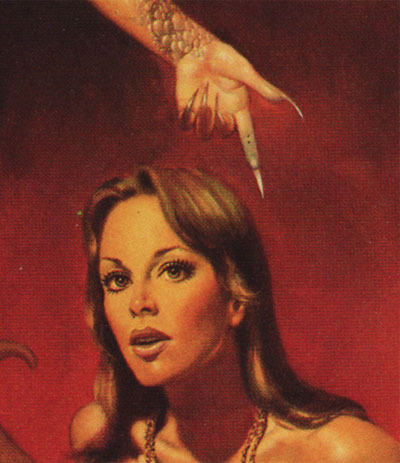

There are exceptions, like A Season at Brighton that shows he can certainly paint expression. You can also see a wider range of expression in his more recent work. Again, this part of his style probably comes from what he’s more interested in painting.
I’ll comment on just one other part of Vallejo’s style. Mythology and folklore loves to take different animals and mash them together, as in the griffin or Pegasus. People are no exception, and the combination of person with animal immediately puts us in a fantastic, mythological frame of mind. Vallejo drew on Nagas for this image, or perhaps the lamia. To someone who paints anatomy like Vallejo does, the puzzles of fitting together human forms with animal ones must present some awfully fun challenges.
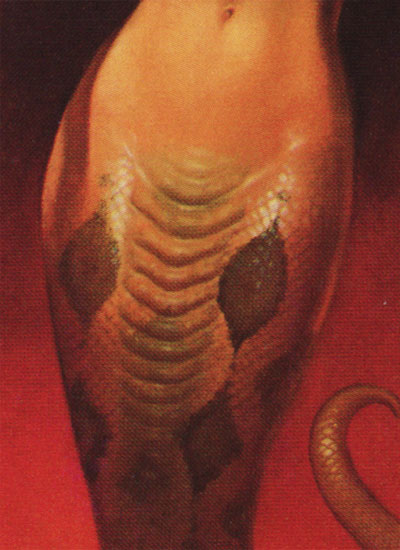
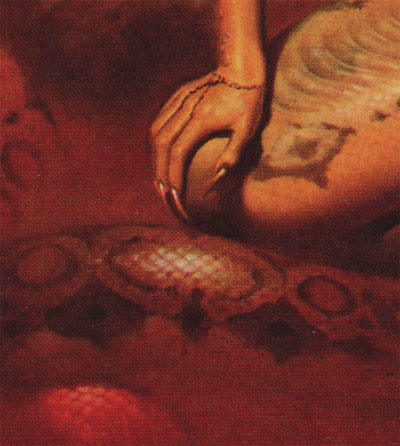
Notice how many aspects of his style have nothing to do with actual drawing or painting technique. Most of them are in his choice of subject matter and approach to the image itself. I often find Vallejo’s choices to be unabashedly cheesy, but awfully fun nevertheless.
The Elements
To wrap up we’ll go through Lee Moyer’s Elements of a Successful Illustration.
Focus: The snake woman in the center is the focus.
Composition and Design: There are two basic loops in play, and the snake woman in the middle as part of both of them. The overall shape is a triangle, and it’s framed by the semicircle border at the top.
Palette: Red, and highly saturated.
Value: It’s a very dark painting, but within the limited range Vallejo uses value to effectively create mass and volume.
Mass: The snake women have weight and presence. The painting would not work if they didn’t.
Texture: The painting is smooth and realistic. Look at the texture of the snake scales in the detail above.
Symbolism: I mentioned the naga and lamia possibilities, as well as the biblical associations that snakes have. There might be an allusion to the Trinity or the three fates, but that’s probably stretching it.
Micro/Macro: I see the most detail in the snake scales and the transitions from snake to human. The actual skin has little detail, and of course there’s not a mole or birthmark to be found. That would be just… weird.
Ornament: Vallejo often uses ornamental and graphic design as part of his work, but there’s not much of it here. The semicircle at the top serves that kind of function, though subtly.
Narrative: This isn’t really the illustration of a specific scene, but we can certainly wonder how we, the viewer, got to this place. If we actually accepted the invitation from these three, would it end as badly as I suspect?
Juxtaposition: Not only is the human/animal combination interesting by itself, but Vallejo purposefully gives us something creepy associations combined with something quite attractive. In the end, I think that serves to increase the creepiness.
Stylization: I addressed this above, but I’ll point you to this picture to see another example of his style. How many of the stylistic elements I listed above do you find in it?
Character: The three women above are more like archetypes than specific individuals.
Tension: The tension between danger and beauty is this painting’s core concept.
Line: No lines in the sense of Mucha or Moore, but Vallejo uses crisp and clear edges where he needs to and lets things get ill defined in other places, like the mass of snakes.
Research/Reference: I believe that Vallejo carefully lights and poses his models. It’s one of the reasons we don’t see many mid-air leaps in his paintings. In this case it wouldn’t surprise me if he actually went to India and got some nagas to pose for him.
Vignette: Strong poses and a focus on the characters make this a compelling vignette.
Perspective: Perspective is not a major part of this painting. The background is misty and indistinct.
That’s it for this time. Next up will be Seven Handed Musician, from Deviant Art. It’s also back to my weekly schedule, assuming the minor life-upheavals are done for now.
What about what is this painting about? Maybe you covered this but I only skimmed over what you wrote. OK, I’ll go back and read a little more carefully. OK, still didn’t notice too much in that area. A snake woman. Snake always implies a kind of evil temptation, biblical, and man fearing creature, also a strange creature, poisonous, yet geometrically patterned, implying some kind of intelligence we aren’t completely cognizant of on a conscious level. A snake woman, beautiful in all three forms…notice the idea of trifecta, or trinity, and the juxtapositiion again of the trinity biblical theme, combined with the cognitive dissonance of it being an “evil” form. Also the human animal combination. Sexuality here is a theme, temptation, the beautiful women, multiple women. This image is doing a lot with that, biblical dissance, sexual imagery, man/animal presentation, natural beauty, and erotic tension. So that is presented, but what is the artist trying to say? I think it’s just a fantasy painting — but it could be trying to flip out or invert christian concepts dealing with sexuality.
@Stephen – I think it is, primarily, a fantasy painting. The book its in explores different aspects of sexuality and eroticism through fantasy paintings. While I mentioned the trinity aspect, snake-people also show up in other cultures, like Nagas from Indian folklore. Another common archetype is the three fates. Then there’s the mother/maiden/crone trinity. That’s a stretch since these three are pretty much identical.